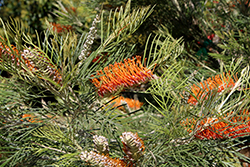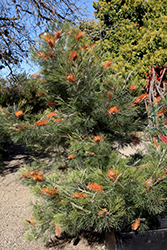Fri & Sat 8am - 8pm
Sun 8am - 7pm
Anytown, USA 12345
fax: 261.787.0463
e-mail: info@successgc.com


Plant Finder

Little Honey Grevillea
Grevillea 'Little Honey'
Height: 6 feet
Spread: 8 feet
Sunlight:
![]()
Hardiness Zone: 8b
Group/Class: GrevilleOz™ Collection
Brand: Ball
Description:
An adaptable species with an upright, airy form; grows well in most well drained soils; large, honey gold and yellow, spidery flower clusters emerge from winter to spring and are good for cutting; finely dissected, ferny green foliage adds great texture
Ornamental Features
Little Honey Grevillea features showy clusters of gold spider-like flowers with orange overtones and yellow tips at the ends of the branches from mid winter to late spring, which emerge from distinctive white flower buds. The flowers are excellent for cutting. It has attractive green evergreen foliage which emerges chartreuse in spring. The deeply cut ferny leaves are highly ornamental and remain green throughout the winter. The smooth gray bark and tan branches add an interesting dimension to the landscape.
Landscape Attributes
Little Honey Grevillea is an open multi-stemmed evergreen shrub with an upright spreading habit of growth. It lends an extremely fine and delicate texture to the landscape composition which can make it a great accent feature on this basis alone.
This is a relatively low maintenance shrub, and should only be pruned after flowering to avoid removing any of the current season's flowers. It is a good choice for attracting birds and butterflies to your yard, but is not particularly attractive to deer who tend to leave it alone in favor of tastier treats. It has no significant negative characteristics.
Little Honey Grevillea is recommended for the following landscape applications;
- Mass Planting
- Hedges/Screening
- Rock/Alpine Gardens
- General Garden Use
- Container Planting
Planting & Growing
Little Honey Grevillea will grow to be about 6 feet tall at maturity, with a spread of 8 feet. It has a low canopy with a typical clearance of 1 foot from the ground, and is suitable for planting under power lines. It grows at a medium rate, and under ideal conditions can be expected to live for approximately 20 years.
This shrub should only be grown in full sunlight. It is very adaptable to both dry and moist growing conditions, but will not tolerate any standing water. It is considered to be drought-tolerant, and thus makes an ideal choice for xeriscaping or the moisture-conserving landscape. This plant does not require much in the way of fertilizing once established. It is not particular as to soil type, but has a definite preference for acidic soils, and is subject to chlorosis (yellowing) of the foliage in alkaline soils. It is somewhat tolerant of urban pollution. Consider applying a thick mulch around the root zone in winter to protect it in exposed locations or colder microclimates. This particular variety is an interspecific hybrid.
Little Honey Grevillea makes a fine choice for the outdoor landscape, but it is also well-suited for use in outdoor pots and containers. With its upright habit of growth, it is best suited for use as a 'thriller' in the 'spiller-thriller-filler' container combination; plant it near the center of the pot, surrounded by smaller plants and those that spill over the edges. It is even sizeable enough that it can be grown alone in a suitable container. Note that when grown in a container, it may not perform exactly as indicated on the tag - this is to be expected. Also note that when growing plants in outdoor containers and baskets, they may require more frequent waterings than they would in the yard or garden.

